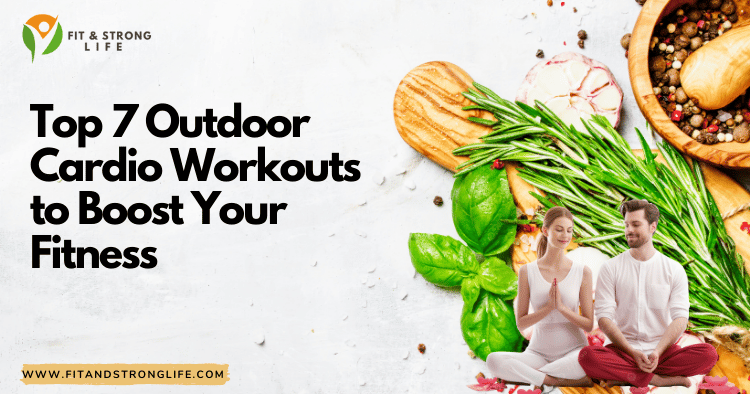Table of Contents
- Why Choose Outdoor Cardio?
- 1. Running or Jogging
- 2. Cycling
- 3. Hiking
- 4. Swimming
- 5. Rowing
- 6. Jump Rope
- 7. High-Intensity Interval Training (HIIT)
- FAQs About Outdoor Cardio
Why Choose Outdoor Cardio?
Outdoor cardio workouts offer a refreshing change from indoor routines, allowing you to connect with nature while enhancing your fitness. Studies have shown that exercising outdoors can lead to greater feelings of revitalization and increased energy compared to indoor workouts. The combination of fresh air, sunlight, and varying terrains makes outdoor cardio not only effective but also enjoyable. Let’s explore the top seven outdoor cardio workouts that can elevate your fitness levels!
1. Running or Jogging
Running or jogging is one of the most accessible outdoor cardio workouts. Whether you’re a seasoned marathoner or a casual jogger, this activity is effective for building cardiovascular endurance.
Benefits:
- Burns Calories: Running can burn between 600-800 calories per hour, depending on your weight and pace.
- Boosts Mental Health: Studies suggest that running can help reduce stress and anxiety levels.
Tips for Beginners:
- Start with brisk walking and gradually increase your pace.
- Use a running app like Strava or MapMyRun to track your progress and stay motivated.
Safety Considerations:
- Always wear proper running shoes to prevent injuries.
- Stay hydrated and choose well-lit paths for early morning or evening runs.
For tips on pre-workout nutrition, check out our article on Top 7 Pre-Workout Foods for Optimal Performance.
2. Cycling
Cycling is a low-impact cardiovascular workout that strengthens your legs and improves overall fitness without putting too much strain on your joints.
Benefits:
- Enhances Leg Strength: Tones your quadriceps, hamstrings, and calves.
- Improves Joint Mobility: A great option for those with joint issues.
Getting Started:
- Choose a local bike trail or park with designated bike lanes.
- Join a cycling group for social motivation and support.
Safety Tips:
- Always wear a helmet and be aware of your surroundings.
- Use hand signals to communicate with other cyclists and pedestrians.
3. Hiking
Hiking combines cardiovascular benefits with the tranquility of nature. The varying inclines and terrain challenge your body and can significantly boost your fitness.
Benefits:
- Full-Body Workout: Engages your core and upper body during climbs.
- Mental Clarity: Being in nature can improve your mood and reduce stress.
How to Get Started:
- Begin with local trails that match your fitness level and progress to more challenging hikes.
- Equip yourself with proper hiking boots and a backpack with essentials like water and snacks.
Safety Considerations:
- Always inform someone of your hiking route and estimated return time.
- Check the weather before heading out to ensure safety.
For more information on outdoor workouts, see our article on Top 7 Benefits of Outdoor Cycling for Fitness.
4. Swimming
Swimming is an excellent full-body workout that is gentle on the joints while providing outstanding cardiovascular benefits.
Benefits:
- Builds Endurance: Swimming laps can significantly enhance your cardiovascular fitness.
- Low Impact: Suitable for all fitness levels and those recovering from injuries.
Getting Started:
- Look for local pools, lakes, or beaches that allow swimming.
- Consider taking swimming lessons if you’re a beginner.
Safety Tips:
- Swim with a buddy, especially in open water.
- Be mindful of water conditions and currents.
5. Rowing
Rowing, whether on a machine or in a boat, is an excellent outdoor cardio workout that targets multiple muscle groups and improves cardiovascular fitness.
Benefits:
- Works Multiple Muscle Groups: Engages your legs, back, arms, and core.
- Caloric Burn: Rowing can burn about 600 calories per hour.
Getting Started:
- If you’re near a body of water, consider joining a rowing club or renting a kayak.
- Try rowing machines at your local gym if you’re not ready to venture outdoors.
Safety Tips:
- Always wear a life jacket when rowing in open water.
- Be aware of boat traffic and follow local regulations.
6. Jump Rope
Jumping rope is a fun and effective way to boost your cardio fitness. It requires minimal space and serves as an excellent workout for your heart and coordination.
Benefits:
- High Caloric Burn: Jumping rope can burn over 700 calories per hour.
- Improves Coordination: This workout enhances your agility and balance.
How to Get Started:
- Choose a jump rope that suits your height and skill level.
- Start with short intervals and gradually increase your duration as you build stamina.
Safety Tips:
- Jump on a softer surface to reduce impact on your joints.
- Wear supportive shoes to provide cushioning.
Also look for tips on nutrition to support your fitness journey in our resources like Top 10 Essential Supplements for Optimal Fitness 2024.
7. High-Intensity Interval Training (HIIT)
HIIT workouts involve short bursts of intense exercise followed by rest or lower-intensity periods. This type of training can be done outdoors and is highly efficient for improving cardiovascular fitness.
Benefits:
- Time Efficient: Achieve a great workout in just 20-30 minutes.
- Variety: HIIT can include various exercises like sprints, jumping jacks, and burpees.
How to Get Started:
- Select a park or open space for your workout.
- Use a timer app or HIIT workout app to structure your intervals.
Safety Tips:
- Warm up properly to prevent injuries.
- Listen to your body and modify exercises as needed.
FAQs About Outdoor Cardio
Q1: How often should I do outdoor cardio?
A1: Aim for at least 150 minutes of moderate aerobic activity or 75 minutes of vigorous activity each week, spread out over several days.
Q2: Is outdoor cardio suitable for all fitness levels?
A2: Yes! Outdoor cardio can be adapted to any fitness level. Start slowly and gradually increase the intensity and duration of your workouts.
Q3: What should I wear for outdoor cardio?
A3: Wear comfortable, moisture-wicking clothing and supportive footwear. Dress according to the weather and consider layering.
Q4: Can I do outdoor cardio in winter?
A4: Absolutely! Ensure you dress appropriately for the cold and choose activities that suit the weather conditions, like cross-country skiing or winter hiking.
Outdoor cardio workouts are a fantastic way to boost your fitness while enjoying nature. Whether you prefer running, cycling, or high-intensity workouts, there’s something for everyone. So grab your gear, step outside, and start enjoying the great outdoors while getting fit!
For more tips, visit our articles on Top 10 Foods to Fuel Your Muscle Gain Journey and Top 10 Nutrition Myths Debunked for Optimal Fitness.




